No Audio on Your Sony TV? 10 Proven Methods to Bring Back the Sound
What To Know
- Fix no sound issues on Sony TVs by rebooting, resetting, or changing audio settings.
- Check and repair speakers, confirm the correct input source, and ensure cables are working.
- Try increasing the volume, adjusting audio output settings, or updating the TV’s firmware.
In this article, I’ll quickly guide you through 10 proven methods to fix the Sony TV no sound issue.
Let’s get started!
10 Reasons Why Your Sony TV is Silent (+ How to Fix Them)
1. TV System Bugs
System bugs are coding errors in your TV’s software that affect its performance. They’re usually undetected until the TV starts to glitch or malfunction.
System bugs can affect different stages of television, including audio delivery. Below are two ways to get rid of them.
Power Cycle The TV
Power cycling (also known as rebooting) shuts down the TV system and erases irrelevant data. The process rids your TV of system bugs and increases its processing speed.
How to power-cycle your Sony TV:
- Unplug your TV from the power outlet.
- Let it sit for 60 seconds.
- Press and hold the Power button for 30 seconds more to drain any residual power.
- Plug the TV back into the outlet and switch it on.
Do A Factory Reset
A factory reset means erasing all user data and settings from your TV, and returning it to its default state. In the process, the TV loses corrupt files, poor settings, and system bugs.
How to factory reset a Sony TV:
With remote
For Sony Android TV
- Press the Home button on the remote.
- Navigate to the upper-right corner of the Home screen and select Settings.
- Navigate to Storage & Reset > Factory Data Reset.
- Choose Erase Everything.
- Select Yes when the confirmation prompt pops up.
For Sony Google TV
- Press the Settings button on the remote.
- Head to System, and then select About.
- Navigate to Reset > Factory data reset.
- Confirm your choice by selecting Factory data reset
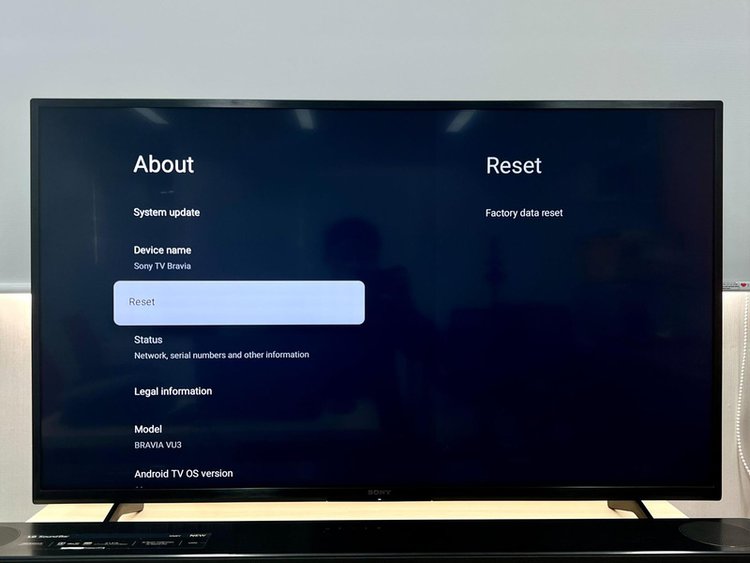
Without remote
- Disconnect the TV from power.
- Press and hold all the buttons on your TV.
- Plug the TV back in while still holding the buttons.
- Hold the buttons until the erasing screen (represented by a rainbow ring) shows up.
2. Faulty or Disabled Speakers
Sometimes, you lose audio because the TV speakers are faulty or the audio settings are incorrect. For example, the TV may be set to the secondary audio output (i.e., external speakers), instead of the TV speakers.
In this case, below are three things you can do.
Enable the TV Speakers
Go to the TV’s settings menu to ensure you’re on the correct audio output settings.
How to set audio output to TV speakers
- On your TV remote, press the Quick Settings or Home button.
- Select Settings.
- Navigate to Display & Sound > Audio Out > Speakers.
- Select TV Speakers.
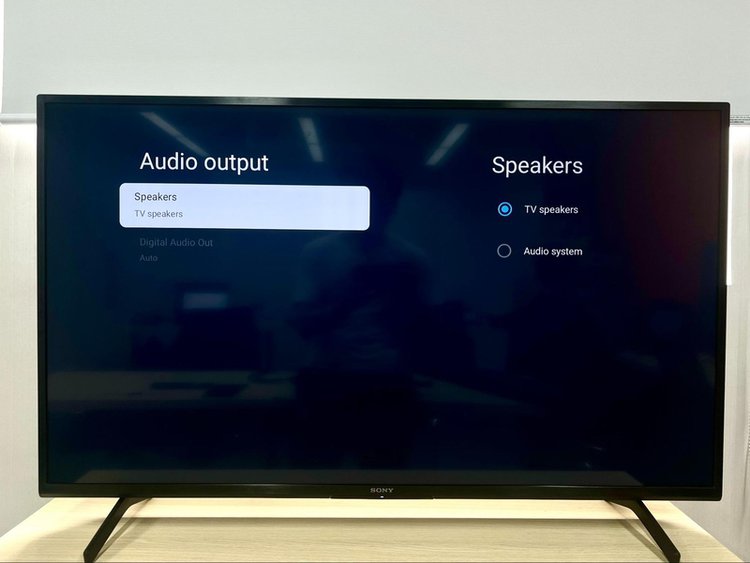
Disconnect External Audio Devices
Some Sony TVs can output audio from the TV speaker and external speakers at the same time. However, a glitch with this function can cause your TV speakers to go silent.
If you’d rather output audio from your TV speakers, disconnect any external audio devices—whether enabled or not.
If the audio device (i.e., soundbar) is connected via HDMI, audio jack, or coaxial cable, simply unplug the cables. For Bluetooth connections, follow the steps below.
How to disconnect Bluetooth audio devices
- Press the Quick Settings or HOME button on the remote.
- Go to Settings > Remotes & Accessories > Bluetooth Settings.
- Navigate to Registered Devices and select your Bluetooth audio device.
- Press Disconnect.
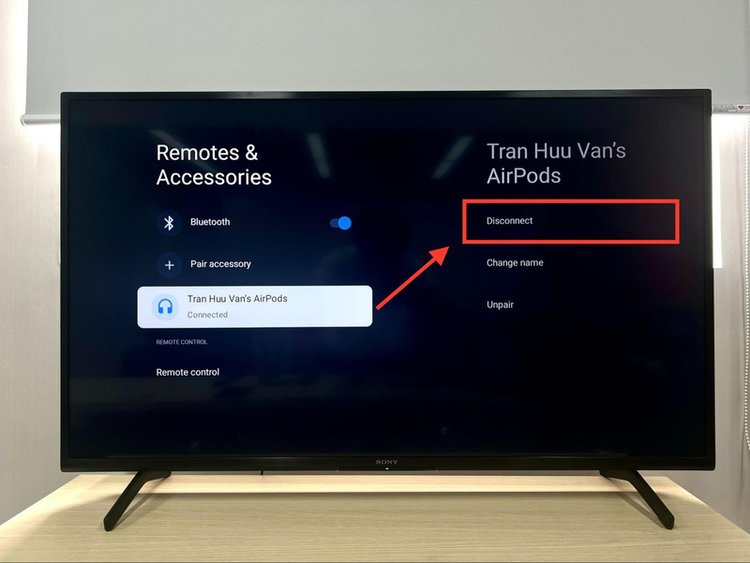
Fix Broken TV Speakers
Your TV speakers can spoil due to wear and tear, electrical issues, or physical damage to the TV. When this happens, you’ll be unable to hear any audio from the TV.
Inspect the speakers on your TV for signs of physical damage (i.e., cracks or tears). If the speakers are broken, repair or replace them.
3. Low Volume Setting
Before considering more complex issues, check if your TV volume setting is low or set to Mute. Ensure the volume is high and the Mute function is not engaged.
Use your TV remote to raise the volume or press the Mute button to cancel the mute setting. You can also use the volume buttons on the TV panel if your remote is faulty or lost.
Because Sony TV models have different button configurations, the steps below will help you navigate the common ones.
TVs with three buttons
These models are more common. They have the Power, (-), and (+) buttons.
- While the TV is on, press the Power button until the Volume function appears on the screen.
- Press the + button to raise the volume.
TVs with one button
- While the TV is on, press the button to show the menu.
- Press the button repeatedly to navigate until Volume + is highlighted.
- Long press the button to increase volume.
4. Input Source Issues
There may be an issue with the TV’s input source settings or the source device itself. To rule out this concern, below are two things to do.
Ensure the Input Source is Correct
If you have multiple devices connected to your TV, ensure that the input setting matches the exact device you’re transmitting from.
How to change the input source
- Press the Input button on the remote.
- Navigate with the arrow keys and highlight your desired input source.
- Press Enter to select.
Test Other Input Sources/Connectors
If there’s no audio from one input source, try other available sources. This test will show if the problem is from a specific input device or connector.
Use the appropriate cables to connect your source device with other connector ports on your TV. If the fault is with a connector port, switch to a different one.
Replace Faulty Cables
Check your connector ports and cables if the above solutions don’t work. Ensure the transmission cables connecting source devices to your TV are plugged in securely.
Also, if you’re using external speakers or audio devices, ensure the connecting cables are in good condition. If they appear damaged or loose, replace them with new ones.
5. Weak TV Signals
If you only lose audio when tuned in to analog broadcast TV, it can be a result of weak signals from the station transmitter or poor tuning. Below are two ways to fix this issue.
Set the TV to Auto-Tune
- On the TV remote, push the Quick Settings button.
- Select Settings.
- Go to Channels & Inputs > Channels > Channel Setup > Auto Tuning.
- Press Setup and select Next. Then wait for the tuning process to finish.
Adjust the TV Antenna
In some cases, your TV antenna may be mounted wrongly. The antenna doesn’t have to be near a window, so find out what’s blocking TV signals and reposition the antenna accordingly.
After adjusting and securing its position to receive strong signals, we recommend you rescan for channels.
6. Volume Offset Feature
Most Sony TVs have the Volume Offset feature that adjusts the volume levels for different inputs or channels. If this feature is enabled and set too high or low, it can cause sound issues.
To fix this, go to the TV’s Settings menu and adjust the volume offset to a more appropriate level.
How to increase Volume Offset
- Press the Quick Settings button on the remote.
- Select Sound Settings and go to Volume Level.
- Adjust the Volume Offset to a higher value.
7. ARC or eARC Functions
ARC and eARC are HDMI functions that return audio from your TV to the source device—ideal for people who use an AV Receiver (or Soundbar). When audio returns to the AVR, it’ll be output through the connected external speakers
The ARC (Audio Return Channel) function requires proper device configuration to deliver audio. Hence, if you’re not set up correctly, you may have trouble getting sound from your external speakers.
Below are boxes to check if you have ARC-enabled devices.
Use High-speed HDMI Cables
You don’t need special HDMI cables for the ARC function. However, we recommend high-speed cables (HDMI 1.4 and above) to improve transmission speed.
On the other hand, eARC is a new technology with specific cable requirements. Use an ultra-high-speed HDMI cable for eARC-enabled devices.
Enable the External Audio Device
- Press the Quick Settings or Home button on the remote.
- Go to Settings > Display & Sound > Audio Output > Speakers.
- Select Audio System.
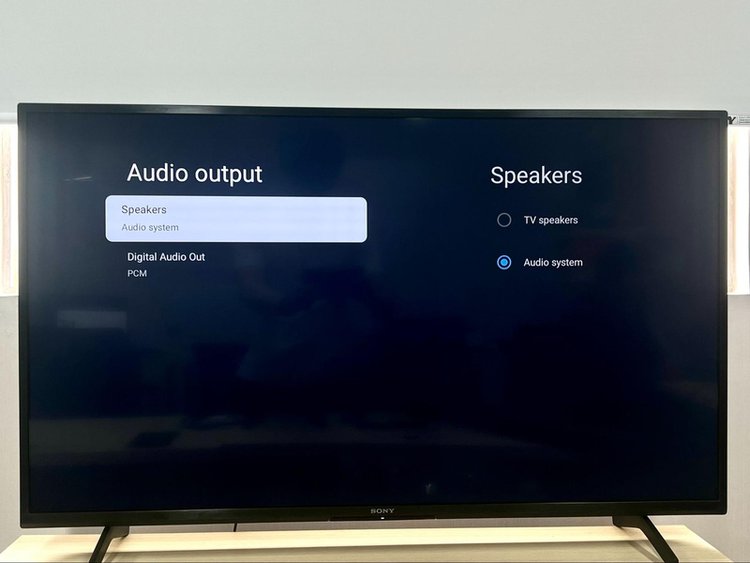
Sync HDMI Control
This synchronization allows you to control all your HDMI-connected devices with one remote controller.
You may experience issues with your audio output if the HDMI control feature isn’t turned on and synced.
How to turn on and sync HDMI control:
- Press Home on the TV remote.
- Navigate to External Inputs > HDMI Set-Up > Control for HDMI.
- Select On.
- Turn on HDMI Control for your AVR or external audio device.
- Press the Sync Menu on the TV remote.
- Go to HDMI Device Selection and select your audio device or AVR.
Note: The steps to access this setting may differ for your Sony TV model. Check your device manual for a more specific guide.
Check Bravia Sync List
The Bravia Sync feature also allows you to control multiple devices with the TV remote. While this feature is convenient, it can cause you to lose audio if it’s not configured correctly.
When using Bravia Sync, ensure your ARC/eARC audio device is on the list of synced devices. Follow the steps below:
- Press the Quick Settings or Home button.
- Select Settings ⚙️.
- Navigate to General Settings > Watch TV > External Inputs > BRAVIA Sync Settings > BRAVIA Sync device list.
- Check the list for your audio device.
- If your audio device is not on the list, replace the connecting HDMI cable with a high-quality one and repeat the process.
- Select Enable.
Clear Cache on ExternalInputServices App
Most new Sony TVs have an ExternalInputServices app that controls the settings for external devices connected to the TV. Simple glitches in the app can cause issues with your TV’s audio output.
We recommend that you clear the ExternalInputServices app cache. Follow the steps below:
- Turn off all devices in the setup (TV, speakers, receivers, etc.)
- Disconnect all HDMI devices from the TV.
- Turn on the TV.
- Press the Quick Settings or Home button on the remote.
- Select Settings.
- Navigate to Apps > See all apps > Show system apps.
- Open ExternalInputServices.
- Select Clear cache and press OK.
- Select Clear data and press OK.
8. Digital Audio Output Settings
TVs have two audio management and output options—PCM and Bitstream. While they are both great, the best option for you depends on your source device.
While the PCM vs Bitstream superiority debate is neverending, PCM is known to have a higher level of device compatibility.
Set Digital Audio Output to PCM
Set your TV’s audio output to PCM if you’re transmitting from an old (analog) media device or any non-HDMI digital connector.
- Press Quick Settings or Home on the TV remote.
- Select Settings.
- Navigate to Sound > Display & Sound (or BRAVIA Settings) > Audio Output > Digital Audio Out.
- Select PCM.
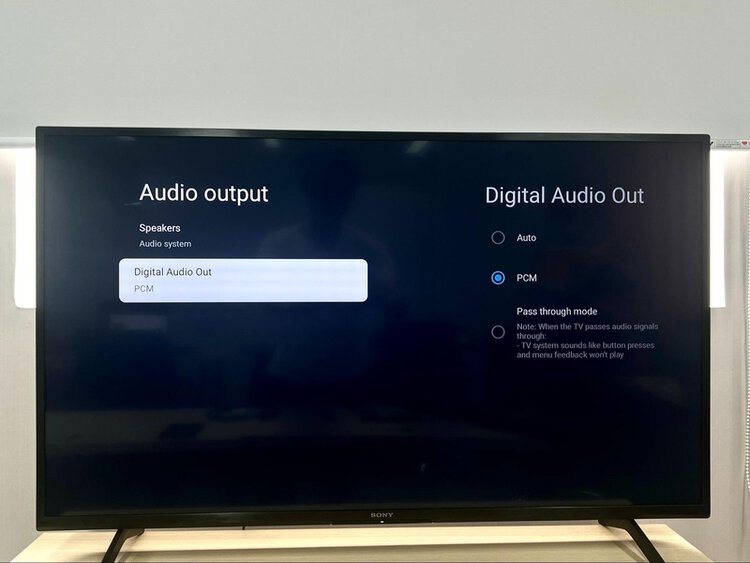
9. Glitchy Sound Settings
Some Sony TV models have audio settings that can affect their audio delivery (i.e., surround sound or audio compression). You must configure these settings correctly to avoid issues with the TV speakers or volume.
Below are three settings and what to do with them.
Change MTS Sound Setting
MTS (Multichannel Television Sound) setting that allows you to switch between different audio channels or modes. If the set mode doesn’t match the signals from your source device, you’ll have issues with audio delivery.
How to adjust the MTS setting
- Press Home on the TV remote.
- Navigate to Settings > Sound > Analog MTS Audio.
- Try out all the options and see which one will fix your issue.
Disable Simulated Audio Effect
Simulated audio effect is a common feature of many modern TVs, which enhances audio quality for built-in TV speakers.
However, with poor configuration, the simulated audio effect can cause low volume or no audio. We recommend that you turn it off entirely.
How to disable the simulated audio effect
- Press Quick Settings on the remote.
- Navigate to Settings > Display & Sound > Sound.
- Go to Sound Customization and disable Surround and Surround Effect.
Reset Sound Settings
You can only use this method for non-smart Sony TVs (Dumb TVs). It will clear any user settings or configurations that may have caused sound issues.
- Press the Menu button on the remote.
- Go to Settings > Preferences > Sound.
- Select Reset and press OK.
10. Outdated Firmware
If none of the above solutions work, it could be a firmware issue. Sony regularly releases firmware updates to fix bugs and improve the performance of their products.
Check for any available firmware updates and install them to see if this resolves the issue with the audio.
How to update your Sony TV firmware
- Press the Home button on the remote.
- Navigate to the left and select Apps.
- Go to Help > Status & Diagnostics > System Software Update > Software Update.
- The TV will search for updates. If an update is available, follow the instructions on the screen.
Conclusion
Nobody wants to turn on their TV and find themselves trapped in an assessment of their lip-reading abilities, because there is no sound. However, it happens!
Not-so-pro tip: Before you throw yourself into a full system analysis, restart your TV. Sometimes, a restart is all you need to resolve communication issues between your connected devices.
If the issue persists, you can move on to changing TV settings or switching connector cables. Follow the guide above to troubleshoot your Sony TV and get the sound working again.
Gabriella ‘Diogo is a technical writer with a vested interest in tech hardware and equipment. She shares her knowledge and processes in an easy-to-grasp, lighthearted style. When she’s not testing or researching device performance, you’ll find her writing short stories or rewatching episodes of her favorite sitcoms.

